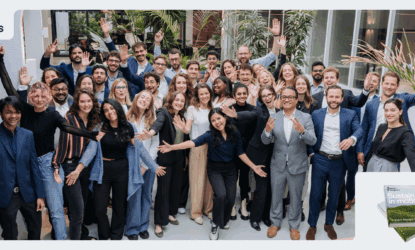 SBTi 2025: Tracking the global shift to science-based climate targets
SBTi 2025: Tracking the global shift to science-based climate targets
On 3 June 2025, sustainability professionals from across Europe joined an in-depth webinar hosted by EcoVadis, featuring expert panellists from EFRAG, EcoVadis, and Nexio Projects. The session provided a timely exploration of the evolving Corporate Sustainability Reporting Directive (CSRD), practical guidance for companies at every stage of their reporting journey, and a live Q&A with some of the field’s leading voices.
Setting the stage: Why CSRD matters
CSRD represents a fundamental shift in how companies approach sustainability, embedding it as a core pillar of business strategy, risk management, and long-term value creation. While the breadth and complexity of CSRD requirements can be challenging, the directive also presents significant opportunities for streamlining and positive impact, as highlighted in the webinar’s opening remarks.
Read our newest guide, helping you through ESG reporting in the Omnibus era.

EFRAG’s perspective: Clarity, simplification, and the road ahead
Dr Liad Ortar, Senior Technical Manager at EFRAG, provided a candid overview of the ongoing revision process for the European Sustainability Reporting Standards (ESRS). Dr Ortar outlined EFRAG’s commitment to simplification and reduction of reporting burdens, describing a rigorous process of engaging stakeholders, benchmarking, and public consultation. The revised ESRS draft is expected late-July.. Every aspect of the ESRS is under review, with a focus on retaining only those data points that deliver genuine value for companies and stakeholders.
Dr Ortar also highlighted the unique position of ESRS in the global landscape, noting its unparalleled regulatory reach and its role in shaping a common language for sustainability disclosures. While efforts to harmonise with frameworks such as GRI reporting standards and IFRS continue, understanding the nuances and leveraging them strategically remains essential for companies operating in this space.
Practical guidance from Nexio Projects: From Double Materiality to strategic advantage
A clear roadmap for organisations preparing for CSRD includes several foundational steps:
- Double Materiality Assessment: This is the cornerstone of any CSRD journey. Not only is it a CSRD requirement, but it also provides a robust foundation for sustainability strategy, regardless of the reporting framework ultimately used. Recent data shows that nearly 80% of global sustainability reports now reference double materiality, underlining its growing importance beyond compliance.
- Gap Analysis: Once the list of material topics is identified, organisations should assess their current management of material topics as defined by the ESRS, namely policies, actions, targets, and metrics.
- Implementation: For each gap identified, companies should ensure that they have a clear roadmap for implementing policies, actions, and measurable targets. .
Watch our on-demand video about DMA best practices.
CSRD preparation should be viewed not merely as a compliance exercise but as an opportunity to benchmark against peers, engage leadership, and embed sustainability into governance structures. Early adopters are already seeing benefits such as improved stakeholder engagement, risk mitigation, and enhanced environmental performance.
CSRD and EcoVadis: Building synergies for effective reporting
There is significant synergy between EcoVadis ratings and CSRD readiness. Organisations that have undergone EcoVadis assessments are often better prepared for CSRD, thanks to overlapping methodologies and a shared focus on materiality, structured disclosure, and continuous improvement.
Nexio Projects, as a global accredited EcoVadis training partner, supports clients with gap analyses, training, and strategic integration of sustainability principles.
Questions that shaped the discussion
The webinar featured a lively exchange of questions and answers, with several key topics addressed to provide practical advice and strategic insights:
Q1: Many audience members are from “Wave 2” companies, meaning their CSRD reporting obligations start later (e.g., for FY2027, reporting in 2028). What critical steps should these companies take now to prepare?
A1: Begin with a robust double materiality assessment, conduct a gap analysis to understand the organisation’s current position on material topics, and ensure clear policies, actions, and targets are set for each material issue. This approach not only ensures compliance but also strengthens sustainability strategy for the future.
Q2: How can companies leverage CSRD reporting as a strategic advantage, even if they are not (yet) in scope?
A2: Use CSRD as a tool for benchmarking against the sector and peers, engage leadership in sustainability strategy discussions, and embed sustainability into governance and internal processes. These steps are relevant for all organisations, including SMEs, and position companies for long-term value creation.
Q3: How does undergoing an EcoVadis assessment support CSRD readiness?
A3: EcoVadis and CSRD share a structured approach to materiality and disclosure. Companies familiar with EcoVadis find it easier to adapt to CSRD requirements, with significant overlap in the sustainability matters covered. Nexio Projects provides support for mapping and optimising these overlaps, and EcoVadis offers platform features to help identify CSRD data points.
Q4: What advice is relevant for SMEs and companies outside CSRD’s immediate scope?
A4: Sustainability remains highly relevant for SMEs, regardless of legal obligations. Voluntary standards such as the VSMEs and upcoming voluntary standards are recommended, and the same foundational steps—double materiality, gap analysis, and leadership engagement—will future-proof businesses.
Q5: Are there tools that help in understanding interoperability between ESRS and EcoVadis?
A5: EcoVadis offers platform features such as a metrics filter to identify CSRD data points, and broader support is available for mapping and optimising overlaps between frameworks.
Looking ahead at sustainability reporting in an era of regulatory uncertainty
While the CSRD might be under scrutiny, sustainability overall will continue to exist. Sustainability reporting has been relevant long before CSRD and will continue being relevant beyond this wave of regulatory uncertainty, even for SMEs.
CSRD is meant to foster transparent and comparable sustainability disclosures, enabling investors to steer financial capital towards green investments and thus achieve the EU Green deal goals of climate neutrality by 2050.
All these objectives are standing and for them to be achieved, the entire economy needs to make the transition, not just large corporations.
Closing thoughts
While the regulatory environment may be evolving and at times complex, the direction of travel is unmistakable. Companies that invest in robust sustainability management and reporting now will not only ensure compliance but unlock strategic advantages in a rapidly changing market.
Nexio Projects supports organisations at every stage of their sustainability journey—offering tailored guidance on Double Materiality Assessments (DMAs), structured sustainability reporting, and compliance with evolving regulations such as the CSRD. Whether you’re just getting started or looking to strengthen your existing strategy, our team provides practical tools, expert-led training, and actionable insights to turn complex requirements into clear, measurable outcomes.
Are you looking for professional support for your double materiality assessment, CSRD alignment, or sustainability reporting?
Get answers on these topics:
- How do you start a Double Materiality Assessment?
- Need help preparing your organisation for CSRD compliance?
- Looking to structure your ESG or sustainability reporting?
- Want expert guidance on stakeholder engagement and data collection?
Check our ESG reporting solutions now and get ahead of the curve!
Who are we? – and why does it matter?
Nexio Projects is a trusted boutique sustainability consulting partner, offering full-spectrum ESG services to businesses aiming to create measurable impact. Named a top 10 global ESG consultancy by Verdantix, our 30+ strong team delivers tailored strategies and implementation support. With clients across 25+ sectors, we understand your industry — and your goals.
How we can help:
- ESG reporting: Our team of ESG reporting specialists and chartered accountants help you navigate the CSRD requirements to achieve compliance.
- Sustainability strategy: Define, develop and implement an integrated sustainability strategy with the dedicated support of our experts.
- Regulatory expertise: ESRS, SFDR, TCFD, CSRD, CSDDD
Our guide can help you understand the next steps, tailored for your organisation’s current roadmap. Read now, and get direct tips for CSRD tailored for your organisation:

Interested in staying up-to-date with regulatory changes in ESG? Our newsletter covers the latest updates monthly, sign up now!
For more information on how we can support your CSRD and sustainability goals, or to access the latest tools and training, please contact us.











